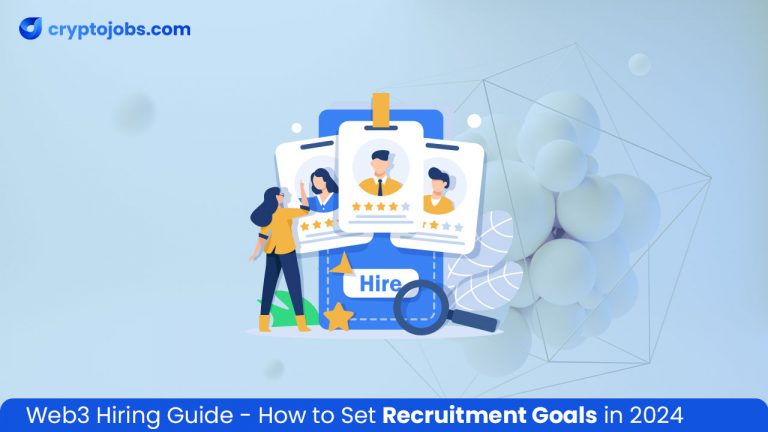
Web3 Hiring Guide: How to Set Recruitment Goals in 2024
- cryptojobs.com
- February 21, 2024
- All Posts, Employer’s Guide
- hiring, Web3
- 0 Comments
In today’s Web3 job market, the competition for the best talents is intense. It has become critical for companies to define their recruitment goals. With unemployment rates in human resource jobs hitting rock bottom, companies are in a desperate hunt for stellar candidates to fill up their ranks.
Therefore, contemporary recruitment teams are increasingly required to raise the bar and improve every stage of the hiring process. This is where the importance of recruitment goals manifests in the Web3 HR jobs.
This guide will explore how to employ smart recruitment and talent acquisition goals in 2024. Using these approaches, you’ll have an edge in the market to not only meet but beat your hiring goals with accuracy and speed.
What Are the Recruitment Goals?
Recruitment goals are HR-devised strategic objectives that guide hiring teams toward achieving specific goals or objectives within set timelines. Such goals have the most impact when meticulously connected with the organizational strategic goals.
Web3 recruitment and talent acquisition tools play a pivotal role in setting direction. It similarly helps human resource departments determine priorities for HR to improve its capability to attract, engage, and onboard top talents.
Through the establishment of definite and measurable goals, organizations can effectively maneuver the intricacies of the recruiting process with certainty and direction, thus propelling them to success in the dynamic digital terrain.
Web3 Hiring Strategies for 2024
When it comes to Web3 hiring strategies for 2024, recruitment goals play a critical role in determining the success of an organization.
Talent Recruitment Goals
These objectives involve strengthening the organization’s ability to attract, hire, and retain top talent with the right skills and culture in human resource jobs.
- Elevating employer branding: For example, improving the positive brand perception among prospective candidates.
- Enhancing candidate experience: For example, improving the entire candidate experience.
- Improving quality of hire: Evaluating performance and cultural fit to acquire better hires.
- Streamlining talent acquisition: Improving the effectiveness of talent acquisition efforts.
- Fostering internal mobility and development: Development and internal career growth provide avenues.
- Leveraging digital HR: Using technology to improve recruitment processes.
- Enhancing talent retention: Developing strategies for better employee retention.
Operational Recruitment Goals
These objectives are aimed at improving the HR department’s hiring processes and capabilities for human resource jobs.
- Strengthening integration with HR and business: Improving collaboration between HR and business units for alignment.
- Improving speed and efficiency: Cutting time to fill positions and simplifying the human resource recruitment process.
- Developing recruitment personnel: Equipping the recruitment team with technological and digital competencies.
- Integrating AI and automation: Using AI and automation tools to have more effective and data-driven recruitment processes.
- Establishing measurement and evaluation metrics: Applying objectives and key results (OKRs) to assess and improve recruitment efficiency.
Benefits of Setting Web3 Recruitment Goals
Setting recruitment goals is imperative when it comes to setting hiring strategies for 2024, offering multifaceted benefits.
Business Strategy into Actionable Outcomes
In the Web3 ecosystem, the recruitment goals function as a connector between a high-level company vision and specific actions on how to attract the most valuable people. Organizations can achieve innovation, increased productivity, and growth through an effective hiring process that aims to identify the best professionals in the market.
Focus On Talent Needs
Recruitment goals in the Web3 era are met by Web3 technologies that give businesses the ability to define their skills, experiences, and cultural attributes clearly. These are necessary for human resource managers to work successfully within the unique context of the Web3 market.
Through identifying and fulfilling talent requirements, companies can create personalized candidate profiles and implement recruitment strategies connected to specific types of persons who can best match the organization’s vision.
Increase Efficiency and Reduce Costs
Single process goals within the Web3 context enable streamlining of both time and resources, thereby improving efficiency while reducing the cost of talent acquisition. Through streamlining recruitment journeys and eliminating inefficiencies, organizations can accelerate the job selection process, reduce the wastage of resources, and achieve big cost savings.
Improve The Quality of Hires
Web3 recruitment objectives aim to raise the benchmark by setting standards around proficiencies, experience, diversity, and many other essential attributes. By establishing clear performance criteria for the selection of candidates, organizations can ensure that every hire adds value to the firm’s success, thus creating a productive workforce capable of spurring innovation and maintaining a competitive edge.
Drive Innovation in Recruitment
The ambitious recruitment goals that the Web3 industry is creating stimulate innovation and move the focus to new horizons of solutions and strategies. Using new technologies and different sourcing channels, organizations can reinvent their recruitment approaches, thereby creating a culture of innovation that leads to the improvement of the overall efficiency and competitiveness of the recruitment process.
Enjoy Steady Progress
Consistent goal setting and measurement performance gives organizations the benefit of tracking the efficiency of their recruitment and the rate at which they are achieving their objectives.
By setting clear benchmarks and measuring the results of new jobs, organizations can identify the areas that call for improvement, apply the changes, and improve their recruitment practices to match the evolving trends and requirements.
Boost Performance
The specific and measurable recruitment goals facilitate accountability and alignment and motivate the participants who are involved in the recruitment.
In expressing aligned objectives and enabling teams to pursue common goals, organizations can improve collaboration, realize performance excellence, and deliver sustainable talent acquisition gains.
Setting Recruitment Goals
Setting recruitment goals in the context of Web3 hiring for 2024 involves a strategic approach encompassing ten key steps:
Step 1: Understand Your Company’s Needs
Commence aligning recruitment goals with your company’s Web3 strategy-focused business plan. Analyze the growth plans, product launches, and the skills required for the upcoming initiatives.
Liaise with departmental heads for a strategic understanding of specific staffing needs, skills shortages, and workload projections for all departments.
Step 2: See the Performance of Previous Years
Assess the preceding year’s recruitment objectives and achievements. Find the areas where improvement is necessary, for example, high turnover rates or the length of the human resource hiring process.
Incorporate HR metrics, such as time-to-hire and new employee retention rate, in your assessment to objectively evaluate the performance and optimization of the recruitment processes.
Step 3: Develop Key Performance Indicators (KPIs)
Re-do the recruiting metrics considering existing priorities. Think of the quality of hires, recruitment efficiency, and employer branding metrics as KPIs that map to organizational goals and Web3 human resource jobs.
Step 4: Put Relevance of Recruitment Goals
Understand the talent market dynamics and emerging HR trends to stay up to date and ensure that the recruitment goals remain relevant. Design strategies beyond the issues like increased productivity and talent pooling.
Step 5: Keep Budget and Resources in Mind
Balance recruitment targets with budget limitations and prioritize the most efficient use of resources. Assess the performance of current Web3 recruitment tools and consider contracting or implementing technology to improve results.
Step 6: Set SMART Recruitment Goals
Use the SMART goal-setting framework in defining specific, measurable, achievable, relevant, and time-bound selection objectives. As an example, target a particular decline in time-to-hire in particular divisions by a given percentage within a specified time at reach.
Step 7: Getting The Approval from The Stakeholders
Involve major stakeholders, such as hiring managers and the top management team, in the goal-setting process to guarantee correspondence and support for recruitment goals.
Step 8: Have Good Communication Skills
Forge a communication plan to broadcast the recruitment targets to relevant team members and stakeholders. Build feedback systems to gather feedback and encourage collaboration.
Step 9: Plan for Continuous Improvement
Keep track of the progress made towards the recruitment objectives consistently and adjust the strategies when market circumstances change. Conducting periodic reviews to evaluate performance and determine potential improvement areas.
Step 10: Celebrate Successes
Pay attention and give feedback on the performance of achievement of the recruitment goal to motivate and engage team members. Celebrate the victories, big and small, to create an environment that supports achievements and ongoing improvement.
You may like to read: Recruitment vs. Talent Acquisition: Understanding the Difference
Examples of Recruitment Goals Tailored for The Web3
If you are curious about recruitment goals, here are examples of recruitment goals tailored for the Web3 industry:
Talent Recruitment Goals
Employer Branding Goals
- Describe the willingness of your organization to publicize salaries, climate adaptation, and sustainability policies in the job adverts using these adverts to portray it as a responsible member of the Web3 community.
- Create captivating narratives through (reviews, videos, and articles) that highlight your company’s culture, values, and employee experiences.
- Genuinely engage on social media and attend industry events to make your organization stand out as an employer of choice, featuring employee testimonials to attract qualified candidates.
- Attract attention and talent by advertising freely on different social media platforms and undertaking sponsored posts to display your company culture and vacancy information.
Candidate Experience Goals
- Ensure a great candidate experience in every contact, and a candidate will refer you and come back.
- Conduct surveys with responses from all candidates to collect insights on their hiring process experiences.
- Customize job postings by referring to unique job descriptions and highlighting the specific benefits to grab audience attention and invite targeted interest.
- Online application simplification: Offer one-click applications through social media or mobile platforms for better user experience and conversion.
Talent Acquirement Goals
Talent Acquisition Goals
- Align talent acquisition with long-term business goals through the identification of the critical skills and competencies required to succeed.
- Produce a talent pool of possible job applicants that can address upcoming and unpredictable needs.
- Pioneer new sources of targeted and niche recruitment channels to source talent within specific niche fields or industries.
- Utilize AI and technology to find the cream of the crop candidates.
Talent Retention Goals
- Increase efforts to establish an attractive and productive workplace, which will help retain staff.
- Keep employees engaged and avoid losing talent from the human resource jobs pool.
- Evaluate all compensation packages in total to make sure they are competitive and highly valued by the staff.
- Improve pay for performance by introducing merit-based incentives to drive engagement and performance.
Operational Recruitment Goals
Integration With Human Resources
- Align recruitment goals with overall Web3 jobs and organizational objectives, involving multiple functions and working effectively with the business.
- Employ technology to take the burden of repetitive tasks in the recruitment process.
- Use AI to improve the candidate experience and reduce human bias in hiring.
- Use AI techniques such as candidate evaluation according to compatibility with company culture and job requirements to improve new hire success rates.
Measurement and Evaluation Goals
- Devise recruitment goals as SMART goals with specific metrics to record the progress.
- Build data-driven capabilities that enable you to analyze data, determine improvement areas, and make timely adjustments to the strategies.
To sum up
To sum it all up, setting recruitment targets in the Web3 industry environment is a continuous process. It calls for round-the-clock vigilance and adaptation. Be systematic and persistent in monitoring progress and always ready to adjust as needed to keep up with the evolving web3 technologies and recruiting innovations.
Finding Web3 jobs in the competitive web3 space can be stress-free with cryptojobs.com, as top Web3 and crypto companies trust the platform for hiring the best talent. Start your job search today and find a position that matches your skillset.




